Simpler Vet Visits
Tips for a PAWfect Checkup
When you decide to bring a dog home, it comes with a lot of responsibility. And one of these items that often comes with stress is the regular vet visit.
Vet visits can come with numerous challenges for humans and their dogs. Some dogs are less comfortable with strangers, especially when it involves getting handled in odd ways. For owners, visits can come with a dizzying number of strange vaccinations, preventives, and worry about their beloved dog’s health.
Fortunately, a little planning can make these appointments more relaxing for you and your dog.
 Start A “Fido” Folder
Start A “Fido” Folder
First, we highly recommend starting a folder where you can save all of your dog’s essential information, from their birth or adoption records to the names and serving sizes/doses of their food, supplements, and medications. You can even save invoices from past vet visits so it’s all in one convenient location.
Having all this information at the touch of your fingers makes it easy to answer any question your vet may ask. It’s also a good spot to keep a running list of questions you may have for your veterinarian.
Practice Makes Perfect
Since vet appointments don’t happen every day, the experience can be very strange for you and your dog. To make things a little easier for your dog, you can practice handling exercises they might encounter during their visit.
For example, spend time touching their paws, belly, tail, mouth, and belly – and don’t forget to offer lots of praise and treats. Over time, you can add gentle squeezing and restraint. Want to take it up a notch? Get a play doctor’s kit to introduce your dog to some of the “odd” tools their vet might use, like a stethoscope, blood pressure cuff, or otoscope.
Just remember to go slow and make the situation positive and relaxing for your dog.
Try Training
Whether your dog loves the vet or finds it stressful, nothing can improve a visit like training. Teaching a dog skills they can turn to in these situations offers numerous benefits, including good behavior and confidence in an unknown situation.
A good starting point involves teaching your dog basic positions, like standing during an exam or going to their “place.” However, our personal favorite is teaching a dog to “touch.” Not only is this a skill dogs often enjoy, but it’s also easy for everyone working with your dog to use. That can help keep your dog distracted during exams and procedures.
Does your dog have a favorite treat that gets their attention every time? Don’t forget to bring it with you to your appointments.
Add Visits for Fun
Finally, it’s completely normal to be scared or unsure of a place you don’t go very often, especially when it involves something that hurts, like an immunization. If possible, try scheduling a visit from time to time that’s just for fun.
Remember to talk to your vet in advance to arrange these stops at convenient times. Plan on spending a few minutes in the lobby or an empty exam room so your dog can become more familiar with the smells, sights, and sounds of the clinic. Make sure to provide lots of praise and treats – and you can even try doing a few of their training exercises at the same time.
If vet visits are still stressful for you and your dog, talk to your veterinarian. While it can be tempting to skip these appointments, they play a vital role in your dog’s health and wellness. When you work with a vet you trust, they can offer personalized recommendations to help make the situation easier in the long run.

